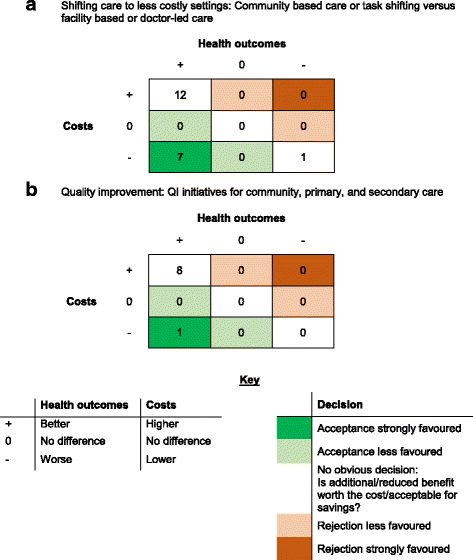Cost-effectiveness of health care service delivery interventions in low and middle income countries: a systematic review
- PMID: 29930989
- PMCID: PMC5992822
- DOI: 10.1186/s41256-018-0073-z
Cost-effectiveness of health care service delivery interventions in low and middle income countries: a systematic review
Abstract
Background: Low and middle income countries (LMICs) face severe resource limitations but the highest burden of disease. There is a growing evidence base on effective and cost-effective interventions for these diseases. However, questions remain about the most cost-effective method of delivery for these interventions. We aimed to review the scope, quality, and findings of economic evaluations of service delivery interventions in LMICs.
Methods: We searched PUBMED, MEDLINE, EconLit, and NHS EED for studies published between 1st January 2000 and 30th October 2016 with no language restrictions. We included all economic evaluations that reported incremental costs and benefits or summary measures of the two such as an incremental cost effectiveness ratio. Studies were grouped by both disease area and outcome measure and permutation plots were completed for similar interventions. Quality was judged by the Drummond checklist.
Results: Overall, 3818 potentially relevant abstracts were identified of which 101 studies were selected for full text review. Thirty-seven studies were included in the final review. Twenty-three studies reported on interventions we classed as "changing by whom and where care was provided", specifically interventions that entailed task-shifting from doctors to nurses or community health workers or from facilities into the community. Evidence suggests this type of intervention is likely to be cost-effective or cost-saving. Nine studies reported on quality improvement initiatives, which were generally found to be cost-effective. Quality and methods differed widely limiting comparability of the studies and findings.
Conclusions: There is significant heterogeneity in the literature, both methodologically and in quality. This renders further comparisons difficult and limits the utility of the available evidence to decision makers.
Keywords: Cost-effectiveness; Economic evaluation; Health service delivery; Service delivery intervention; Systematic review.
Conflict of interest statement
Not applicable.The authors declare that they have no competing interests.
Figures


References
-
- Wang H, Naghavi M, Allen C, Barber RM, Bhutta ZA, Carter A, et al. Global, regional, and national life expectancy, all-cause mortality, and cause-specific mortality for 249 causes of death, 1980–2015: a systematic analysis for the global burden of disease study 2015. Lancet. 2016;388:1459–1544. doi: 10.1016/S0140-6736(16)31012-1. - DOI - PMC - PubMed
-
- Drummond M, Sculpher M, Claxton K, Stoddart G, Torrance G. Methods for the economic evaluation of health care programmes. 4. Oxford: Oxford University Press; 2015.
-
- Lilford RJ, Chilton PJ, Hemming K, Girling AJ, Taylor C a, Barach P. Evaluating policy and service interventions: framework to guide selection and interpretation of study end points. BMJ 2010;341:c4413–c4413. - PubMed
Publication types
LinkOut - more resources
Full Text Sources
Other Literature Sources

